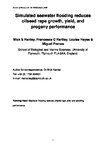Simulated seawater flooding reduces oilseed rape growth, yield, and progeny performance

Date
2019-03-28Author
Subject
Metadata
Show full item recordAbstract
BACKGROUND AND AIMS: Of the many threats to global food security, one of the most pressing is the increased incidence of extreme weather events. In addition to extreme rainfall, a combination of global sea level rise and storm surge is likely to result in frequent episodes of seawater flooding in arable systems along low-lying coasts. Our aim was to elucidate the effects of simulated seawater and freshwater flooding on the survival, growth and reproductive potential of four cultivars of the important seed crop, Brassica napus [canola, or oilseed rape (OSR)]. METHODS: Established plants were exposed to 24 or 96 h freshwater or seawater root zone immersion (with a no immersion 'control'). Initial post-treatment performance over 7 weeks was quantified using dry weight biomass. A second group of plants, cultivated until maturity, were used to quantify reproductive yield (siliqua and seed number, and seed size) and subsequent progeny performance (germination and seedling growth). RESULTS: Oilseed rape growth and reproductive responses were unaffected by freshwater, but seawater negatively affected growth and siliqua number for all cultivars, and seed mass for two ('Agatha' and 'Cubic'). In addition to impacts on crop yield, the growth of seedlings cultivated from seed collected from maternal plants subjected to seawater immersion was also reduced. CONCLUSIONS: Our results demonstrate the potential impact of seawater inundation on coastal cropping systems; although OSR may survive acute saline flooding, there are longer term impacts on growth and yield for some cultivars. The threat may necessitate changes in land-use practice and/or the development of salt-tolerant cultivars to maintain economically viable yields. In addition, by evidencing a hitherto unknown effect on reproductive performance (i.e. reduced seed yield) and subsequent seedling growth, our study highlights an important potential impact of coastal flooding on plant community dynamics for (semi-) natural habitats.
Collections
Publisher
Place of Publication
Journal
Volume
Issue
Pagination
Recommended, similar items
The following license files are associated with this item:

